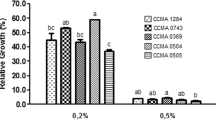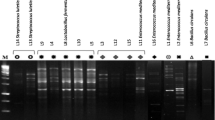Abstract
The study evaluated the safety and colonisation properties of four lactic acid bacteria (LAB), by determining their cell hydrophobicity and aggregation abilities. In addition, the presence of virulence and resistance genes was assayed in these probiotic candidates. Lactobacillus reuteri ZJ625, Lactobacillus reuteri VB4, Lactobacillus salivarius ZJ614 and Streptococcus salivarius NBRC13956 were tested for cell surface hydrophobicity abilities against xylene, chloroform and ethyl acetate. The isolates were also tested for auto-aggregation and co-aggregation abilities; the optical densities of cell growth were measured after 1, 2, 3 and 4 h of experimental set-up. DNA was extracted from all the four isolates and amplified using PCR with specific primers to detect virulence genes of adhesion collagen protein (ace) and aggregation substances (agg and asa); also, resistance genes of Vancomycin vanA, Vancomycin vanC1 and Vancomycin vanC2/3 were assayed in the four isolates. The isolates showed high hydrophobicity to all solvents: xylene (78–84%), chloroform (68–75%) and ethyl acetate (52–60%). High auto- and co-aggregations ranging from 60 to 70% and from 45 to 56% respectively were observed in the isolates after 4 h of incubation at 37 °C. Some of the tested isolates showed the presence of virulence and resistance genes; however, this does not indicate that these genes are unsafe because their transmission and expression abilities are unknown. Therefore, in this study, the isolates studied are considered safe for use as future probiotics, as revealed from results presented, which generally represents the scanned safety evaluations of the isolates as promising probiotics.



Similar content being viewed by others
References
Andrabi ST, Bhat B, Gupta M, Bajah BK (2016) Phytase-producing potential and other attributes of lactic acid bacteria isolates for prospective probiotic application. Probiotics Antimicrob Protein 8:121–129
Andriantsoanirina V, Teolis AC, Xin LX, Butel MJ, Aires J (2014) Bifidobacterium longum and Bifidobacterium breve isolates from preterm and full term neonates: comparison of cell surface properties. Anaerobe 28:212–215
Anu PS, Keerthi TR (2013) Adhesion and cell surface properties of wild species of spore formers against enteric pathogens. Asian Pac J Trop Med 6:110–114
Ashraf R, Shah NP (2011) Antibiotic resistance of probiotic organisms and safety of probiotic dairy products. Int Food Res J 18:837–853
Balakrishna A (2013) In vitro evaluation of adhesion and aggregation abilities of four potential probiotic strains isolated from guppy (Poecilia reticulate). Braz Arch Biol Technol 56:793–800
Bernardeau M, Gueguen M, Smith DGE, Corona-Barrera E, Vernoux JP (2009) In vitro antagonistic activities of Lactobacillus spp. against Brachyspira hyodysenteriae and B. pilosicoli. Vet Microbiol 138:184–195
Bennedsen M, Stuer-Lauridsen B, Danielsen M, Johansen E (2011) Screening for antimicrobial resistance genes and virulence factors via genome sequencing. Appl Environ Microbiol 77:2785–2787
Casey PG, Gardner GE, Casey G, Bradshaw B, Lawler PG, Lynch PB, Leonard FC, Stanton C, Ross PR, Fitzgerald GF, Hill C (2007) A five-strain probiotic combination reduces pathogens shedding and alleviates disease signs in pigs challenged with Salmonella enteric Serovar Thypimurium. Appl Environ Microbiol 73:1858–1863
Dunne C, O’Mahony L, Murphy L, Thornton G, Morrissey D, O’Halloran S, Feeney M, Flynn S, Fitzgerald G, Daly C, Kiely B, O’Sullivan GC, Shanahan F, Collins JK (2001) In vitro selection criteria for probiotic bacteria of human origin: correlation with in vivo findings. Am J Clin Nutr 73:389–392
Gómez NC, Ramiro JM, Quecan BXV, de Melo Franco BDG (2016) Use of potential probiotic lactic acid bacteria (LAB). Biofilms for the control of Listeria monocytogenes, Salmonella typhimurium, and Escherichia coli 0157:H7 biofilms formation. Front Microbiol. https://doi.org/10.3389/fmicb.2016.00863
Escamilla-Montes R, Luna-González A, Flores-Miranda MC, Álvarez-Ruiz P, Fierro-Coronado JA, Sánchez-Ortiz AC, Ávila-Leal J (2015) Isolation and characterization of potential probiotic bacteria suitable for mollusc larva cultures. Thai J Vet Med 45:11–21
Haitham AR, Zaiton H, Norrakiah AS, Hud-Faujan N (2017) Assessment of potential probiotic properties lactic acid bacteria from shrimp paste of belacan. Int J Adv Res Sci Eng Technol 5:90–98
Hassan MH, Belal EB (2016) Antibiotic resistance and virulence genes in Enterococcus strains isolated from different hospitals in Saudi Arabia. Biotechnol Biotechnol Equip 30:726–732
Janković T, Frece J, Abraham M, Gobin I (2012) Aggregation ability of probiotic Lactobacillus plantarum strains. Int J of Sanit Eng Res 5:19–24
Li Q, Liu X, Dong M, Zhou J, Wang Y (2015) Aggregation and adhesion abilities of 18 lactic acid bacteria strains isolated from traditional fermented food. Int J Agric Policy Res 3:84–92
Lim SM, Ahn DH (2012) Factors affecting adhesion of lactic acid bacteria to caco-2 cells and inhibitory effect on effect on of Salmonella typhimurium. J Microbiol Biotechnol 22:1731–1739
Muresan A, Sârbu I, Pelinescu D, Ionescu R, Csutak O, Stoica I, Vassu-Dimov T (2017) In vitro selection of some lactic acid bacteria strains with probiotic potential. Rom Biotechnol Lett 23:1–14
Nami Y, Haghshenas B, Haghshenas M, Khosroushahi AY (2015) Antimicrobial activity and the presence of virulence factors and bacteriocin structural genes in Enterococcus faecium CM33 isolated from ewe colostrum. Front Microbiol 6. https://doi.org/10.3389/fmicb.2015.00782
Papadimitriou K, Zoumpopoulou G, Foligne B, Alexandraki V, Kazou M, Pot B, Tsakalidou E (2015) Discovering probiotic microorganisms: in vitro, in vivo, genetic and omics approaches. Front Microbiol 6. https://doi.org/10.3389/fmicb.2015.00058
Pieniz S, de Moura TM, Cassenego APV, Andreazza R, Frazzon APG, de Oliveira Camargo FA, Brandelli A (2015) Evaluation of resistance genes and virulence factors in a food isolated Enterococcus durans with potential probiotic effect. Food Control 2:49–54
Ramirez-Chavarin ML, Wacher C, Eslava-Campos CA, Perez-Chabela ML (2009) Probiotic potential of thermo-tolerant lactic acid bacteria strains isolated from cooked meat products. Int Food Res J 20:991–1000
Ramos CL, Thorsen L, Schwan RF, Jespersen L (2013) Strain-specific probiotics properties of Lactobacillus fermentum, Lactobacillus plantarum and Lactobacillus brevis isolated from Brazilian food products. Food Microbiol 36:22–29
Sadrani H, Jayantilal D, Vyas BRM (2014) Screening of potential probiotic Lactobacillus strains isolated from fermented foods, fruits and of human origin. Asian J Pharm Clin Res 7:2014–2025
Sharma K, Sharma N, Sharma R (2016) Identification and evaluation of in vitro probiotic attributes of novel and potential strains of lactic acid bacteria isolated from traditional dairy products of North-West Himalayas. J Clin Microbial Biochem Technol 2:18–25
Soccol CR, de Souza Vanderghe LP, Spier MR, Medeiros ABP, Yamaguishi CT, Lindner JD, Pandey A, Thomaz-Soccol V (2010) The potential of probiotics: a review. Food Technol Biotechnol 48:413–434
Soleymanzadeh N, Mirdamadi S, Kianirad M (2017) Incidence of virulence determinants and antibiotic resistance in lactic acid bacteria isolated from Iranian traditional fermented camel milk (Chal). J Food Biosci Technol 7:1–8
Taheri HR, Moravej H, Tabandeh F, Zaghari M, Shivazad M (2009) Screening of lactic acid bacteria towards their selection as a source of chicken probiotic. Poult Sci 88:1586–1593
Thantsa MS, Mathipa MG (2017) Probiotic engineering: towards development of robust probiotic strains with enhanced functional properties and for targeted control of enteric pathogens. Gut Pathog 9:1–17
Toğay SÖ, Keskin AC, Acik L, Temiz A (2010) Virulence genes, antibiotic resistance and plasmid profiles of Enterococcus faecalis and Enterococcus faecium from naturally fermented Turkish foods. J Appl Microbiol 109:1084–1092
Vlková E, Rada V, Smehilova V, Killer M (2008) Auto-aggregation and co-aggregation ability in Bifidobacteria and Clostridia. Folia Microbiol. https://doi.org/10.1007/s12223-008-0040-z
Wassenaar TM, Klein G (2008) Safety aspects and implications of regulation of probiotic bacteria in food and food supplements. J Food Prot 71:1734–1741
Wassenaar TM, Zchüttig A, Beimfohr C, Geske T, Aurbach H, Cook H, Zimmermann K, Gunzer F (2015) Virulence genes in a probiotic E. coli product with a recorded long history of safe use. Eur J Microbiol Immunol 5:81–93
Wassenaar TM, Gunzer F (2015) The prediction of virulence based on presence of virulence genes in E. coli may not always be accurate. Gut Pathog 7:15
Wei YX, Zhang ZY, Liu C, Malakar PK, Guo XK (2012) Safety assessment of Bifodobacterium longum JDM301 based on complete genome sequences. World J Gastroenterol 18:479–488
Xu H, Jeong HS, Lee HY, Ahn J (2009) Assessment of cell surface properties and adhesion potential of selected probiotic strains. J Appl Microbiol 49:434–442
Funding
This work received support from the Agricultural Research Council – Animal Production, Irene, South Africa; the Red Meat Research & Development South Africa (RMRDSA) and the South Africa Medical Research Council.
Author information
Authors and Affiliations
Corresponding author
Ethics declarations
Conflict of Interest
The authors declare that they have no conflict of interest.
Rights and permissions
About this article
Cite this article
Dlamini, Z.C., Langa, R.L.S., Aiyegoro, O.A. et al. Safety Evaluation and Colonisation Abilities of Four Lactic Acid Bacteria as Future Probiotics. Probiotics & Antimicro. Prot. 11, 397–402 (2019). https://doi.org/10.1007/s12602-018-9430-y
Published:
Issue Date:
DOI: https://doi.org/10.1007/s12602-018-9430-y




